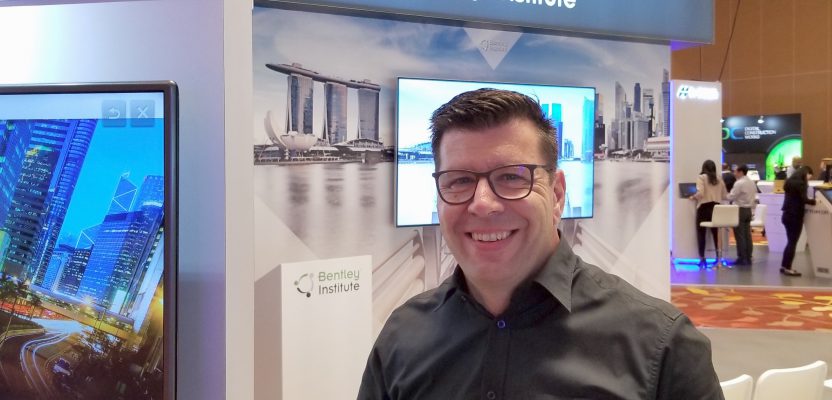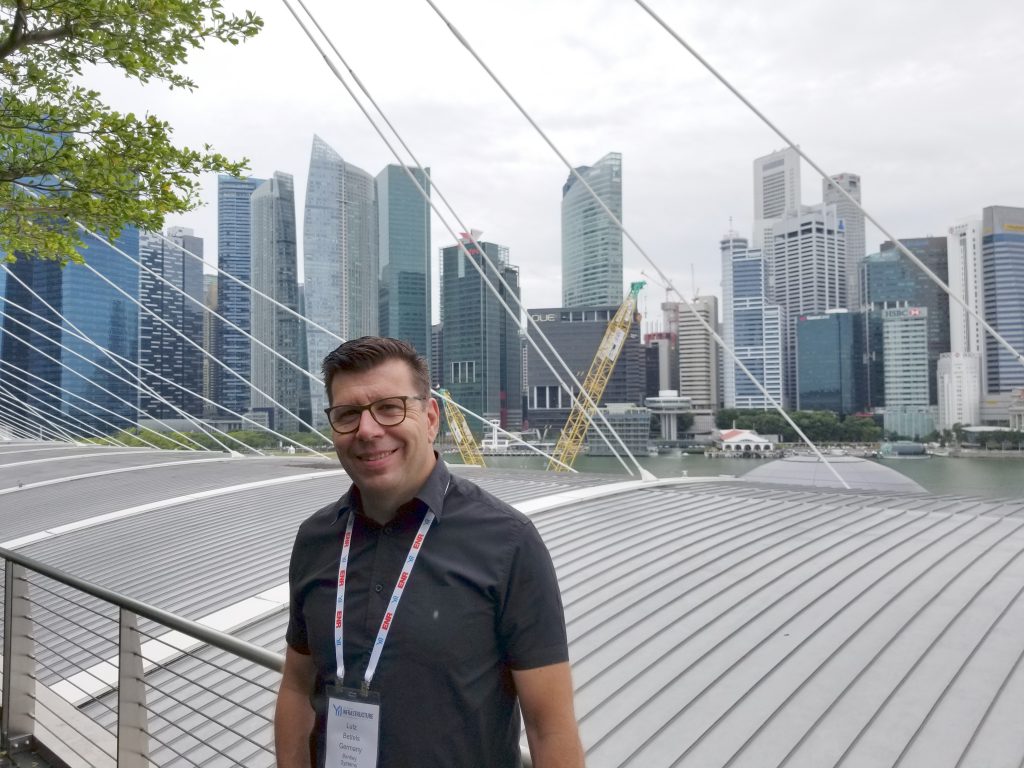xyHt’s Nick Duggan spoke with Lutz Bettels, vice president, regional executive at Bentley Systems, at Intergeo 2019, just before Bentley’s Year in Infrastructure Conference.
Nicholas Duggan (ND): What is Bentley, and what do you do there?
Lutz Bettels (LB): Bentley is involved in everything around infrastructure. If somebody were to ask me what Bentley is doing, my short answer would be: everything, except for mechanical design.
Infrastructure Asset Management
LB: Any kind of infrastructure asset, whether it’s a building structure, road tunnel, or railway: this is something we want to be involved in and provide software solutions for that industry—also for the entire lifecycle of the project.
Originally Bentley was coming from the design area, with MicroStation being our flagship product, but over the years and decades we’ve evolved into a solution provider capable of managing the asset over its entire lifetime. We still have all the good design solutions for all the trades and disciplines, but we also have solutions to manage the data along the lifecycle: what’s called a common data environment.
We’re providing CDEs for the design and construction phase and the data handover into the operations phase, as well. Our Asset Wise solutions are also capable of managing a digital twin after the BIM model is completed; that is something we cover, as well.
ND: Wow, that’s a lot of products! It must get rather confusing when you span such a large lifecycle.
LB: Yes, indeed we have some 200–odd products in our portfolio, and there are very few people who know them all. With our collective wisdom, we [gather] those solutions together and provide specific solutions for different infrastructure types. They are the playbooks we are creating for the different disciplines. We then promote them amongst our user base.
[The “Playbook” is an actual book that’s about the size of U.S.-letter paper and thick, like an Encyclopedia Britannica (Oh, the irony of Googling it!). Within the pages are use cases from a lot of users, each on a page and each detailing how their project achieved its goals using the different Bentley solutions.]
ND: How long has Bentley been around?
LB: This year Bentley celebrates its 35th anniversary, so we are 35 years young! INTERGEO has become an important event for us. The past couple of years the focus of INTERGEO has changed from surveyors and hardware–types to a more solutions–orientated event where you have every aspect of data capture, planning, and construction integration; it is very interesting for us.
Context for Digital Twins
ND: Do you have something new you are announcing here at INTERGEO?
LB: The big buzzword at the moment is “digital twin,” and we have jumped on that band wagon, as well. With BIM and other technologies, you are already able to build a twin for the planning and construction phase and continue that to the operational phase.
The biggest difference to our story is that you have the digital twin—you have all the associated information for that model, but that model is just a model, so it is just a context. What we are adding to the digital twin is digital context.
With the technology we have that allows you to capture information, through point clouds, through drone flights, [through] photogrammetry, you can create a 3D reality model of the context of the digital twin so you’re capable of embedding your digital twin to digital context.
From a construction perspective, then, you see the situation on a construction site, whether you have space for storing your materials on site or whether certain pieces are going to be delivered to the site or will find their way there without breaking down. Knowing this kind of information is adding value to the digital twin.
We are also adding the dimension of time to measure the project’s progress. That’s something on display here with our Synchro software but also integrated into Microsoft Hololens, an augmented environment on site that compares the status with the as–built status.
Digital Cities
The last big thing we are showing here is in the context of digital cities. That is, again, a digital twin story that says, “Okay, we get all this great information, but it is all locked up into silos of information.” With our digital cities solution we are able to aggregate and integrate all this information and present it in a very user friendly way—in a way that city information is published on the websites of cities and municipalities, and you can access any of the smart information that was embedded in that model.
It is very graphical, very visual—it’s touch screen—and you don’t need any prior knowledge of BIM models or digital twins at all. The main thing is that in the background we are capable of integrating and aggregating all this information.
ND: People seem to be looking for more automated and simplified solutions now. Is this a direction that Bentley is also looking?
LB: I would say that we haven’t mastered design and construction yet, but one thing missing for the owners and the communities is being able to take advantage of all this information that’s being created. Therefore, it is really important to have that digital twin story, and of course, your UK digital twin initiative is a good one! So, it is really important that we release and unlock this information for the general public so they will benefit from the data, as well.
I-format Hub
LB: Bringing all this data together and presenting it in an easy–to–use way is a new initiative for us. The underlying technology for this is called the I-format hub. That is our cloud–based technology that allows us to aggregate all the information together and present it in a web interface.
ND: Is there anything on your roadmap that you can share with xyHt?
LB: The next big thing is the I-model hub/digital twin story. This is a huge technology effort for us, and we are pooling large resource into it to make it market–ready and to make it publicly available. Bentley does a lot, but we don’t do everything, and there are a lot of other vendors out there that need to integrate into our new technology.
What we said last year and what has become more important this year is that we will make access to that technology open source. The SDKs [software development kits] to develop digital twins in the Bentley world are open–source available that you can get from GitHub.
ND: So, is this where we are going with openBIM?
LB: Yes! That is part of the openBIM initiative.
ND: Thank you very much for your time, Mr. Bettels. I look forward to hearing more about the I-model format soon.


